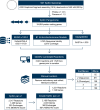A validated pangenome-scale metabolic model for the Klebsiella pneumoniae species complex
- PMID: 38376382
- PMCID: PMC10926698
- DOI: 10.1099/mgen.0.001206
A validated pangenome-scale metabolic model for the Klebsiella pneumoniae species complex
Abstract
The Klebsiella pneumoniae species complex (KpSC) is a major source of nosocomial infections globally with high rates of resistance to antimicrobials. Consequently, there is growing interest in understanding virulence factors and their association with cellular metabolic processes for developing novel anti-KpSC therapeutics. Phenotypic assays have revealed metabolic diversity within the KpSC, but metabolism research has been neglected due to experiments being difficult and cost-intensive. Genome-scale metabolic models (GSMMs) represent a rapid and scalable in silico approach for exploring metabolic diversity, which compile genomic and biochemical data to reconstruct the metabolic network of an organism. Here we use a diverse collection of 507 KpSC isolates, including representatives of globally distributed clinically relevant lineages, to construct the most comprehensive KpSC pan-metabolic model to date, KpSC pan v2. Candidate metabolic reactions were identified using gene orthology to known metabolic genes, prior to manual curation via extensive literature and database searches. The final model comprised a total of 3550 reactions, 2403 genes and can simulate growth on 360 unique substrates. We used KpSC pan v2 as a reference to derive strain-specific GSMMs for all 507 KpSC isolates, and compared these to GSMMs generated using a prior KpSC pan-reference (KpSC pan v1) and two single-strain references. We show that KpSC pan v2 includes a greater proportion of accessory reactions (8.8 %) than KpSC pan v1 (2.5 %). GSMMs derived from KpSC pan v2 also generate more accurate growth predictions, with high median accuracies of 95.4 % (aerobic, n=37 isolates) and 78.8 % (anaerobic, n=36 isolates) for 124 matched carbon substrates. KpSC pan v2 is freely available at https://github.com/kelwyres/KpSC-pan-metabolic-model, representing a valuable resource for the scientific community, both as a source of curated metabolic information and as a reference to derive accurate strain-specific GSMMs. The latter can be used to investigate the relationship between KpSC metabolism and traits of interest, such as reservoirs, epidemiology, drug resistance or virulence, and ultimately to inform novel KpSC control strategies.
Keywords: Klebsiella; bacterial metabolism; genome-scale metabolic models; genomics; pangenome.
Conflict of interest statement
The author(s) declare no conflict of interest.
Figures





Similar articles
-
A curated collection of Klebsiella metabolic models reveals variable substrate usage and gene essentiality.Genome Res. 2022 May;32(5):1004-1014. doi: 10.1101/gr.276289.121. Epub 2022 Mar 11. Genome Res. 2022. PMID: 35277433 Free PMC article.
-
A genome-wide One Health study of Klebsiella pneumoniae in Norway reveals overlapping populations but few recent transmission events across reservoirs.Genome Med. 2025 Apr 28;17(1):42. doi: 10.1186/s13073-025-01466-0. Genome Med. 2025. PMID: 40296028 Free PMC article.
-
Limited Transmission of Klebsiella pneumoniae among Humans, Animals, and the Environment in a Caribbean Island, Guadeloupe (French West Indies).Microbiol Spectr. 2022 Oct 26;10(5):e0124222. doi: 10.1128/spectrum.01242-22. Epub 2022 Sep 12. Microbiol Spectr. 2022. PMID: 36094181 Free PMC article.
-
Antimicrobial Resistance of Hypervirulent Klebsiella pneumoniae: Epidemiology, Hypervirulence-Associated Determinants, and Resistance Mechanisms.Front Cell Infect Microbiol. 2017 Nov 21;7:483. doi: 10.3389/fcimb.2017.00483. eCollection 2017. Front Cell Infect Microbiol. 2017. PMID: 29209595 Free PMC article. Review.
-
Colonization, Infection, and the Accessory Genome of Klebsiella pneumoniae.Front Cell Infect Microbiol. 2018 Jan 22;8:4. doi: 10.3389/fcimb.2018.00004. eCollection 2018. Front Cell Infect Microbiol. 2018. PMID: 29404282 Free PMC article. Review.
Cited by
-
Wild-Type Domestication: Loss of Intrinsic Metabolic Traits Concealed by Culture in Rich Media.Microb Ecol. 2024 Nov 21;87(1):144. doi: 10.1007/s00248-024-02459-z. Microb Ecol. 2024. PMID: 39567391 Free PMC article.
References
MeSH terms
Substances
LinkOut - more resources
Full Text Sources

